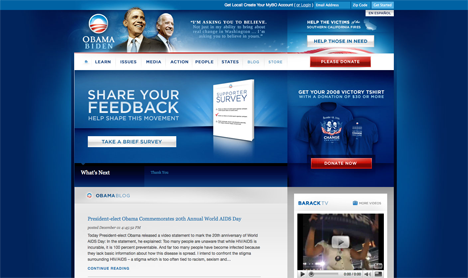
The Barack Obama campaign web site
Shortly after President-elect Barack Obama won on November 4th, I met with a few of our clients and advised them that it wouldn’t be long before companies began to analyze and emulate many of the digital strategies employed by the Obama campaign during the 2008 elections. I fully expected companies to thoughtfully study the various aspects of Obama’s digital strategy, evaluate them and integrate the aspects that best suit their businesses in order to bring their digital efforts into the 21st century.
Silly me!
What I had not anticipated was that clients would begin to cherry pick Obama’s strategies, acknowledging those with which they already have a predisposition while downplaying others altogether. The Obama campaign successfully wove together an outreach and engagement strategy that utilized external social networks (Twitter, Facebook, Meetup, etc.), internal social networks (My Barack Obama), messaging via YouTube, email and SMS (text messaging) in order to excite and mobilize it’s massive base of eager volunteers.
Recently, however, I’ve had the experience of meeting with clients and having them reduce Obama’s digital strategy into one single tactic or killer app: “Obama won because of Twitter!” “Obama won because of all those YouTube videos!” “Obama won because of his SMS campaign!”
Of course, as each of us knows, there is no killer app. There are no short cuts. No outreach/engagement campaign could be as simple as simply putting up “a Facebook group”. To be sure, the Obama campaign worked very hard to hone and perfect its digital strategy over time — improving on certain aspects of it that worked while minimizing or eliminating aspects that did not — and the same will be true for any organization that wishes to leverage the social web in building its brand.
Last year, when the Obama campaign first launched its My.BarackObama.com social network — which allows anyone to create their own blog on the Barack Obama web site — the decision was met with raised eyebrows in many a corporate boardroom. Many of those organizations are still debating whether it should even have a blog, let alone whether or not they should allow their users unfettered access to their site and the ability to maintain unmoderated blog content which the company does not, and cannot, control.
Earlier this year, when artists like Wil.i.am and Obama Girl began to pepper YouTube with content that was not sanctioned by the campaign and, in Wil.i.am’s case, did so by using and reproducing content from an Obama speech for which they did not request or receive prior written consent, they engaged in activities that would have gotten them sued by many corporations.
Every company/brand says it wants to deepen the level of engagement between itself and its consumer base. Too many, however, wish to do so in the traditional, one-way method of communication rather than in the establish true levels of engagement by letting go of control of their brands and letting their consumers take control.
As long as companies and brands continue to cherry pick tactics used by Obama rather than embrace the overall strategy of engagement, they will continue to talk at their consumers rather than to establish a meaningful dialogue.
.chris{}





























